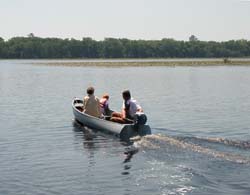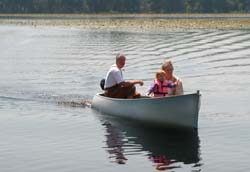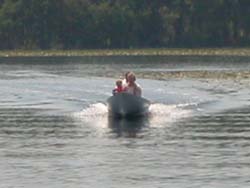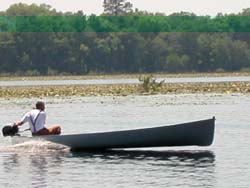Robb White
Boatbuilder
Rescue Minor
Machinery Details
Sport Boat Plans In the olden days, sport boats were built like a wood-canvas canoe. Old Town built them and so did Penn Yan and a bunch of others, (especially in Canada) but the most famous sport boat was built by the Grumman aluminum canoe company in Marathon, NY. I have a Grumman sport boat that I have owned for almost fifty years. It was ideal for my uses on the rivers, lakes, ponds and sloughs around here. Or at least I thought it was until I built my first "Grumman sport boat improvement project." Though I copied the old aluminum boat pretty closely, wood makes a much better boat.... The improvements were lighter, faster, planed with less hp at lower speed, ran level and did not pound or throw water like the old aluminum boat did. Specifications
Performance The boat will easily plane two adults with 3 hp. and will run like all-get-out with this engine. I recommend five or six hp. Plans, $75 pp. Accurate with full sized mold tracings and complete instructions. The first boat built from these plans was built by a high school shop class in Greenback, Tennessee. The story that follows appeared in Messing About in Boats sometime in the middle nineties. It explains the origin of this situation.The Chickenfeed BoatI have an aluminum Grumman "Sport Boat". I know, what with all the pontificating I do, that such news is probably a shocker so I guess I'll have to explain myself... do a little more pontificating. I am no kind of purist about anything except for how I don't like to do anything that I don't want to do. I just love a good small boat (I am at best, indifferent about big boats, they are kind of more trouble than joy, I have a long list of little things that I won't lay on you at this time). It doesn't make any difference if the thing is made out of roto-moulded polyethylene or galvanized tin, a good boat is a good boat and a Grumman "Sport Boat" is a good boat. Of course, it ain't quite as good as the one in the shop right now... an open sea rowboat sixteen feet long by six feet wide by probably less than a hundred pounds hull weight and so strong that three stooges couldn't stomp the bottom out of it but a Grumman Sport Boat is a good boat... took me many years to figure out how to build something better. The first Grumman Sport Boat I ever saw was way back in the middle 50's and I only caught the briefest glimpse of it on a trailer on the paved road behind a V8 Ford station wagon. I tried to get a better look but Momma's 36 horse Volkswagen just couldn't catch up no matter how hard I hunched behind the wheel. I was relentless in my pursuit even as a boy (fifteen at the time with a special drivers license that I had had since I was 14 because we lived so far beyond the school bus run) and it didn't take me long to interrogate around and find out what kind of boat it was. Then I set to get me one and an outboard motor to go with it. At first I tried to coerce my Father into springing for the money by the use of eloquent explanation but he said "We already got the Reynolds so what do we need another aluminum boat for?" "It is so light and easy to handle that y'all wouldn't have had such a mess on that Ochlocknee River trip that time." said me. "I don't have any plans for another Ochlocknee river trip in the near future, so I don't need the ideal boat." was his final statement. With that, I knew I had to get me a job and buy the boat on my own. I went to work for the "Chicken King of Cairo, Georgia" (that's pronounced "Karo" like the corn syrup that originated in that metropolis). I didn't have to submit my resume or stand for an interview or anything. The job was unloading boxcars of chicken feed at fifteen bucks a car and if you could do it before the railroad deadline, the job was yours, if you couldn't... and particularly if you couldn't pay the demurrage for the extra day (coincidentally, also $15.00) your ass was gone. I was kind of small and unused to hard work but I was smart. I slipped in the side door as a striker for a big black man whose name will remain anonymous since I don't know what the statute of limitations situation is for some of the crimes that I heard him tell about in the close association we had in the chicken feed cars. Robert had been a bootlegger during the best years of that business back in prohibition days. He had a series of stills back in the tributaries of the Ochlocknee river and was so slick that not only did he not get caught but managed to employ a good many folks and expand his business... "Had a still on every creek", said he. My family owns a good little bit of the land of the Ochlocknee drainage system. "Hell, boy, we had them all over y'allses place... yo grandaddy was my best customer." said Robert. My grandfather was already dead by then so I never got a chance to find out all about it but he was a fearsome bad alcoholic and never had to do without. He was the most wonderful man but that is another story. Another thing about Robert... he was in the train wreck when the shaky trestle over the Ochlocknee River at Hadley Ferry broke down and the sawmill train fell in the river and scalded all those men to death in 1925. He was the fireman in the engine and ought to have been the first one to die but he dove under the water and, though the concussion of the implosion made him bleed out the ears, he was the only survivor of the whole crew... had to walk twenty miles to tell the news and nobody believed him because he was just a (...) ((I ain't going to say that word because my Momma taught me not to). So I tried to help Robert unload that chicken feed for free for a long time. I was too light to handle the damned hand trucks on the steep ramp. I holp (ed. that's an actual word in wide usage in the rural South... kind of substituted for "helped" but not in all cases... I won't labor over it right now) load and trotted down behind Robert to help stack the bags but I could see that I would never be able to carry my end unless I could get to where I could get down the ramp without letting the load get away from me. I tried half loading but Robert said "Boy, you kinda getting in my way with all that." One day (this mess went on seven days a week) Robert had to go to Memphis on business and sent his nephew to take his place. The very first thing that happened was that the nephew let the hand truck get loose from him on the ramp and busted open about eight paper bags of feed. I said "Boy, you kinda getting in my way with all that". It took me from then until car moving time at 9:00 the next morning (about 26 hours) to unload that boxcar but I did it... fifteen bucks.. big money. I don't remember what all I had to do that time, but I finally evolved a way to brake the hand truck with, first my shoes and then two pieces of flat belt that I riveted around the axle and stood on to drag on the ramp to slow the buggy down a little. Pretty soon I was able to ride the truck down the ramp, steering with my "brakes" sort of like a hot-shot skateboard kid these days. Robert and I teamed up. He loaded his buggy while I rode mine down and dumped it at the bottom, then I would hurry back up the ramp with the empty buggy and get the next load. After the car was empty, we would double-team stacking the sacks down in the warehouse. Piece-work in the face of poverty will make an efficiency expert out of most anybody and Robert and I made some pretty good money... enough for me to order a brand new Grumman Sport Boat and buy a second-hand, three horse, two-cylinder, Evinrude weedless three made in Belgium (and you thought "outsourcing" was new) in 1951. We both lost our jobs at the same time over oyster shell supplement. At that time, ground oyster shells were either mixed with chicken feed or fed separately. A train car loaded with oyster shell was a bitch. Though the flimsy paper bags were much smaller than a fifty pound bag of feed, they weighed 90 pounds and the car waiting on the siding was just as full as it could be. It was real hard to even pinch any oyster shell car up to the dock and it was almost impossible to beat the demurrage deadline, no matter how bad we busted our asses. I am afraid that I was the one who feisted up at the "Chicken King" about it and cost us our jobs (which were eagerly taken up by lesser men who had to work late into the night even with carloads of straight laying mash). I felt guilty and told Robert. "Unloading chicken feed ain't all I know to do." he said and I think he went into the rooster fighting business with some Cubans down around Miami but that's just a supposition. He is still alive. In fact, he is the one I get my gardening advice from. He told me to go ahead and set out my tomato and pepper plants after the new moon of February 5th. "Dang, Robert ain't that mighty early?" said me. "Naw, it's all over. You might have to cover them up with a sheet one or two times but they need to be in the ground with that hot manure." said he. I noticed the last time I passed his place that his were even bigger than mine. I think it might have something to do with all them roosters in those little cages behind his house. Note: Grumman Sport Boats are no longer built because (somebody told me) it was impractical to put flotation high enough up so that a sunk boat would pass the test and stay right side up with the engine that it was rated for (6 hp.) perched up on that flat-topped transom and five people sitting bolt upright on the seats. I saw one that had plastic doohickeys along the sides in an effort to comply but that was a long time ago. Though mine is an antique (47 years old at the time of this writing) it has enough flotation to hold up the engine, people and the picnic too, of course, the people would probably have to get out of the boat. There is a long, useless foredeck with a bunch of some kind of primitive foam bulkheaded up under it (I think it is still in there) and the whole stern thwart (Sport Boats have three regular seats) is boxed in with foam. That's a case where they regulated out a good thing. I don't know but I bet there have been fewer people drowned in Grumman Sport Boats than there have been strangled to death with the prize in boxes of Cracker Jacks. All the people I have ever seen with one of those boats did not look like the kind that normally fool around and drown themselves. A Grumman boat is fifteen feet eight inches long by forty four inches wide (not counting the damned bush catching outboard oar lock sockets). The transom is thirty two inches wide which separates it completely from a "square stern canoe". It is made with a good tumblehome to the stern which makes the boat paddle about like a canoe, actually better with only one person than a standard seventeen foot Grumman canoe. You'll know why canoes have tumblehome after you have paddled one of those straight sided fiberglass monstrosities of the seventies all day long. It is impossible to pull a tumblehome boat out of a one-piece mold and paddling one that you can pop out will get you right between the shoulder blades from having to reach so far out to clear the rail. Though I have paddled my boat many a mile, such is not the best propulsion method. A Grumman Sport Boat is a rowboat with few peers. You have to get mighty fancy to beat one with anything that short and wide (why, when I was thirty years old.....). I like eight and a half foot oars and my extra high homemade aluminum oar locks (don't use bronze). I learned a lot about rowboats trying to improve on that boat all these years. It ain't the shape of the front of the hull and certainly not anything to do with all those rivet stumps sticking out of that extruded "T" beam keel that makes the boat row so well, it is the fact that it has almost no rocker to the bottom and about a planing boat stern. Despite what I always thought, the stern of a displacement boat does not have to stick up any higher out of the water than necessary to clear the stern wave at the speed you are going to be able to make with the load you intend to carry. The Whitehall transom sits up there so high because the man who was doing the work knew he was going to have a boat load on the way to and from the whorehouse. When I'm pulling in the stern station of my old boat all by myself (no matter where I am going) the transom trims about half an inch in the water at rest which is a "no, no". You can "no, no" all you want to but you better save your breath if you intend to pull up far enough to see how she trims when underway without having to crank your neck (When I was thirty years old......). I finally figured it out. A Grumman Sport Boat hardly pitches at all when rowed hard. The little drag the transom makes when slightly immersed as the boat tries to squat at the beginning of the stroke is offset by its steadying influence. I think that pitching makes the wavelength of the bow and stern wave longer and the amplitude higher than what is normal for a non-pitching boat running at hull speed. The net effect of pitching in a rowboat is to make it act like it has a shorter waterline length than it actually does and is going faster than it actually is. Now, all my rowboats have a good wide transom close to the water but it took a long time to get it right. Which, I wish I could build one for something like the Blackburn Challenge but getting back to the original problem, it costs a lot of money to outrun a Grumman Sport Boat and the folks that are still strong enough to pull hard for that long can't afford the boat. Oh well. The other obvious thing that makes the boat run so well is that it is sort of light. Mine weighs a hundred and thirty five pounds. There is a lot of erroneous lore about boats and one is that old foolishness about how a heavy rowboat carries its way better and that is supposed to offset the fact that you have to move all that extra displaced water out of that way. If heavy boats rowed better, it would be possible to win races with a lot less money. As for me, I ain't ever had any boat that I wished weighed another pound. Another lesson I learned from my old chicken feed boat is that boats that are light, narrow and easily driven at displacement speeds will plane most efficiently too. My old aluminum boat will plane two grown people with a weedless three. I don't know of any other production boat that will do that. With one person and a long tiller extension my boat will run eleven knots with that old fifties engine. The transition from displacement to planing is so subtle that it is impossible, without leaning over the transom, to tell when it happens. There is never any wake. I figured that out too. What happens is that the boat begins to plane before it gets to its hull speed so it never makes enough disturbance in the water to have to climb any bow wave or tear away from any stern wave to get going. I have built a bunch of boats that run that way and I believe that sixteen feet on the water is about the minimum. With boats that are borderline too short (like the Grumman) you have to make sure that you trim by the bow so you get all you can get of hull speed. That leads us into the problem section. A Grumman Sport Boat is not ideal. It has about the same bow shape at the bottom as an aluminum canoe... no deadrise...almost flat. That makes it, not only wet, but bad to pound. My old boat will slap even the lightest chop hard enough to knock the oxide dust loose to blow back in my eyes (along with the spray). Even at low speed.... rowing... the boat pounds and throws water in a chop. That makes it unpleasant in anything but smooth water. It is dangerous in rough conditions. If you trim it by the bow like you need to do to ease off on the pounding and get any practical displacement speed, it will root into the back of a following sea or one of those big, almost stationary waves that you find at inlets and river mouths on a falling tide. I don't think it would take much misjudgment to root one of them bad enough to broach around and turn over and drown somebody. If you don't trim by the bow, the damned thing will not go to windward if it is even a little bit rough. It will pound so bad that you can't stand it and stick its bow up so high that you won't be able to hold it into the wind. About the only thing you can do when it breezes up is get back in the stern and go downwind. A Grumman Sport Boat ain't no sea boat.I'll tell you this though. Mine stays in use, the bottom is shiny from pushing through so many lilly pads and acres of grass. There is no telling what it would read on the hour meter if it had one. It will go right in the back of a pickup truck and we can snatch it out and be long gone before the bass boat crowd gets through discussing the necessity of being able to go seventy mph (statute) up the river. They won't ever see us when they finally get fired up because we will have dragged old "Chickenfeed" over into some virgin slough somewhere and will already have two or three big red bellies that have never seen a metal flake in their lives. Whooee.... Dang, let me put this computer down, I already had to pull the boat out of the bushes so I could measure it to set down the facts, might as well just slide her on in the truck... might go see if old Robert wants to go, he got them big black wigglers all around under his rooster cages.
Here are some more pictures of it under way. To give an idea of the load, I weigh 190 my wife weighs 130 and that baby is a pretty good sized little sport, too. The engine weighs 40 pounds.
Stern and bow views.
It planes out real well. The length is such that the boat reaches
planing speed before it reaches hull speed so it does not pitch the
bow up and bog along.
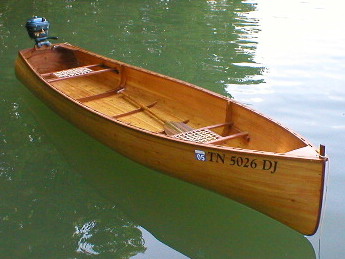 This is the boat built at the High School
in Tennessee to our plans. Turned out pretty good didn't it? This is the boat built at the High School
in Tennessee to our plans. Turned out pretty good didn't it? |
||
![]()
ROBB WHITE & SONS INC.
Designers and Builders of Custom Small Boats Since 1961
P.O. Box 561, Thomasville, GA 31799
Copyright © 2004 - 2006 byRobb White. All rights reserved.
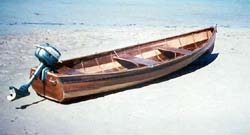
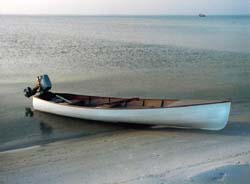
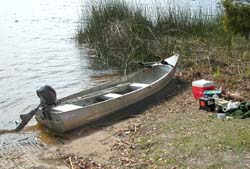
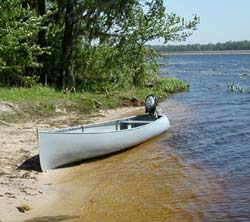 This
is the prototype built in our shop. It is a good little boat (if
I do say so myself). I painted it gray to make it look like an
aluminum boat and to make it as durable. It is completely sheathed
in fiberglass and epoxy and, in my experience, that makes a durable
boat if you don't fool around and varnish the thing. My old
Grumman is in pretty bad shape. At least this one won't corrode.
This
is the prototype built in our shop. It is a good little boat (if
I do say so myself). I painted it gray to make it look like an
aluminum boat and to make it as durable. It is completely sheathed
in fiberglass and epoxy and, in my experience, that makes a durable
boat if you don't fool around and varnish the thing. My old
Grumman is in pretty bad shape. At least this one won't corrode.